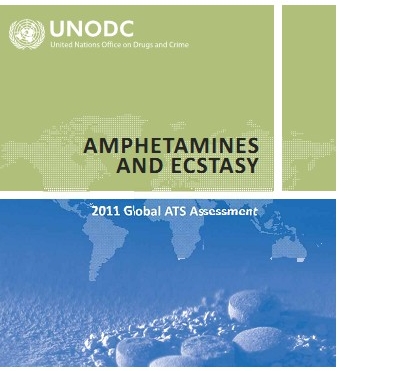Amphetamine-type stimulants ranked world's second most used drug after cannabis
 Vienna. 13 September 2011. A new report released today by the United Nations Office on Drugs and Crime (UNODC) ranks amphetamine-type stimulants (ATS) such as ecstasy and methamphetamine as the world's second most widely used type of drug after cannabis. Offering the most comprehensive and current analysis of the situation, the
2011 Global ATS Assessment notes that the expansion of the drug's trade and the high criminal profits pose an increasing threat to security and health worldwide.
Vienna. 13 September 2011. A new report released today by the United Nations Office on Drugs and Crime (UNODC) ranks amphetamine-type stimulants (ATS) such as ecstasy and methamphetamine as the world's second most widely used type of drug after cannabis. Offering the most comprehensive and current analysis of the situation, the
2011 Global ATS Assessment notes that the expansion of the drug's trade and the high criminal profits pose an increasing threat to security and health worldwide.
While heroin and cocaine have attracted the majority of attention in recent years, ATS seizure figures and the discovery of clandestine laboratories show a rapidly growing area of concern. ATS seizures (with the exception of ecstasy which remained constant) showed a clear increase between 2005 and 2009. Affordable and easy to manufacture, ATS are attractive drugs of choice for millions of drug users in all regions of the world and offer criminals a new entry into unexploited and fresh markets. Unlike plant-based drugs such as opiates or cocaine, synthetic drugs can be manufactured anywhere with little initial investment required on the part of criminals.
South Africa possibly the world's largest consumer of mandrax
The annual prevalence of amphetamines-group substances in Africa is estimated to be between 1.2 and 8 million people, with the highest annual prevalence rates being reported from South Africa, which is possibly the world's largest consumer of mandrax (methaqualone). Nigeria, Burkina Faso, Côte d'Ivoire, Egypt, Ghana, Kenya, Senegal, Sierra Leone and several other African countries have reported ATS use in recent years.
Since 2006, fears have been growing that African countries are being used as trans-shipment points for shipments of precursor chemicals such as ephedrine and pseudoephedrine, the main chemicals used in the manufacture of ATS such as methamphetamine and methcathinone from Asia. The final destination of these chemicals is in countries in Central and North America, and to a lesser extent, South Africa.
ATS such as methamphetamine (known as tik), methcathinone (known as cat) and ecstasy continue to pose major threats to South Africa, having witnessed a steady increase in use over the past decade. Methamphetamine and methcathinone as well as mandrax, are manufactured in the country for local use. Most ATS laboratories are small-scale operations, often located in residential areas. However, the number of reported ATS laboratories as well as the amount of precursor chemicals smuggled to or through South Africa seem to have declined.
Commending the efforts of the South African government, UNODC Regional Representative for Southern Africa, Mr. Mandiaye Niang, said "The continuous efforts by the South African government to strengthen legislation and reporting measures to prevent the diversion of precursors are possibly responsible for this decline".
However, South Africa remains an attractive location for drug traffickers to warehouse their stocks before shipping them on to other countries. The Australian Crime Commission listed South Africa and Zambia among the main points of embarkation for ATS shipments seized in Australia. Detections from these two countries accounted for about 20% of the total amount of ATS detected at the Australian border in 2008/2009.
The use of ATS through intravenous means is another emerging concern with widespread health issues particularly given its links to the spread of HIV and AIDS. Indicators point towards a rise on this front most notably in East and South-East Asia, as well as parts of Western and Eastern Europe. It is also likely to be a contributing factor to increasing drug-related crime rates in South Africa. Research by the Institute for Security Studies has linked the increase in crime to the higher volume of illicit drugs in the market, highlighting the growth of the drug scene since the appearance of methamphetamine on the illicit market.